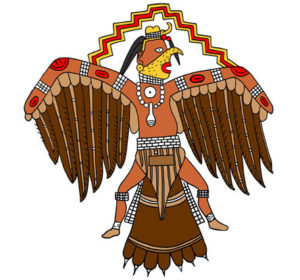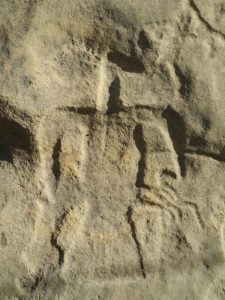By Andrew Berry
Please come out tomorrow, January 18th at 11:00 for a lecture on golden eagles at the Bernheim Visitor Center entitled ‘Return of the Thunderbird’. It will cover the Bernheim Golden Eagle Project in its entirety with lots of background info, pictures, maps, and history. I will also answer any and all questions about golden eagles, Bernheim, or anything related to wildlife or forests!

Harper continues to spend time in the central sections of Bernheim Forest with brief travels onto neighboring properties. Recently cameras have captured at least four different golden eagles within Bernheim, but due to difficulties in identification by feather patterns it may be as high as six. The Christmas Bird Count led by Beckham Bird Club turned up 3 golden eagles, and a staggering 16 bald eagles from the Greater Bernheim area.
In the first part of this series we discussed how Neanderthals and Native Americans interacted with golden eagles. In the second part we want to further examine how Native Americans may have left clues to their interactions with golden eagles. Looking at the migration route of Harper, our golden eagle from Bernheim, we examined his migration route and compared it to sites of known artifacts or petroglyphs depicting raptors, commonly referred to as thunderbirds by archeologists.

Harper is a midwestern eagle, a group that appears to be somewhat distinct from western populations that utilize the Rocky Mountains and Coast Ranges. They also seem to be separate from the Appalachian golden eagles that utilize the mountainous corridor for migration and breed on the eastern side of the Hudson Bay. The midwestern, or Mississippian golden eagles, are known to breed on the western shore of the Hudson Bay and utilize a popular bird migration route on the western tip of Lake Superior in Duluth, Minnesota. Comparing Harper’s and other midwestern routes for golden eagles to known Native American raptor or thunderbird artifacts showed some interesting trends.

Archeological sites throughout the Midwest associated with the Mississippian Culture contain artifacts and petroglyphs that bear resemblance to golden eagles. Petroglyph sites in Wisconsin, Illinois, Missouri, and Kentucky that contain thunderbird images are also sites where golden eagles are spotted in the winter. It is certain that the Mississippian tribes had some knowledge of golden eagles, and they may have been an influence on the spiritual figure known as the Birdman, depicted as a human figure cloaked in feathers and ornaments. Many of the existing Mississippian Birdman artifacts have long feathers much like golden eagles, which is in line with use of feathers in other tribes into modern times.
From copper plates and gorget artifacts found throughout Mississippian Culture sites, we see that birds are a common theme. Archeologists have attributed these to being raptors or falcons, although many appear to resemble golden eagles. One particular copper artifact, the Peoria Falcon, is an artifact found along Peoria Lake in Illinois. This site is very close to Harper’s migration route, within 50 miles of Peoria Lake. Illinois is a key migratory route for midwestern golden eagles, and early cultures were likely familiar with their seasonal arrivals. Looking at golden eagle sightings near Peoria, IL on ebird shows many current sightings along that stretch of the Illinois River.

Petroglyphs in several sites including the Lemonweir petroglyph site in Wisconsin bear a strong resemblance to golden eagles. There are seven raptors described as thunderbirds depicted on a bluff near the Lemonweir River. The site is significant in the thunderbird-golden eagle link because it is located within a mile of Harpers migratory route. These bluffs may have been carved with the 7 thunderbirds to depict a common migratory route for golden eagles, possibly as a location for eagle trapping. Other sites such as Roche-A-Cri in Wisconsin contain thunderbird petroglyphs and is known for golden eagle sightings.
Thunderbird petroglyphs exist in other known golden eagle locations. Shawnee National Forest in southern Illinois contains some exceptional golden eagle habitat and wintering sites in the lower Ohio Valley. One area called Eagle Mountain is still a destination for seeing golden eagles during winter months, further corroborated by sightings on ebird. On Millstone Bluff is a petroglyph of a thunderbird, near to a native American village site on top of the prominence. Again this would be an ideal site for seeing or trapping golden eagles, and an obvious location for wintering golden eagles in the Mississippi Valley.

A rock shelter below a ridgetop site near Berea, KY contains a petroglyph of a thunderbird. This area is very favorable as habitat for wintering golden eagles, as indicated by the golden eagle habitat model and personal communications of sightings in the knobs around Berea. It is located on the edge of the knobs with large views extending across the Bluegrass. It is an ideal location for golden eagles and may have been a site for viewing or trapping golden eagles in the past.
Eagle trapping was a common practice that is well documented in Native American history. Golden eagle feathers were highly prized by many tribes across North America as spiritual items, indicators of status, and as ornamentation during ceremonies in headdresses and clothing. Feathers were valuable currency, and no doubt the golden eagle feathers were a specialty product as they are still highly valued in present times by Native Americans. Much effort was put towards trapping the eagles, using bait while concealed on a high ridge where golden eagles would patrol. Once the eagle came down to take the bait, the waiting hunter reached out of concealment from beneath the bait and grasped the eagle by the legs. Once secured they would either pluck feathers or the entire bird would be processed for all talons and feathers.
This may sound like a heavy dose of speculation, and it certainly requires a strong imagination based on reality. I believe it is plausible given the information about Wyoming thunderbird/golden eagle associations that the Mississippian petroglyphs of raptors/thunderbirds may have indicated golden eagle trapping sites. It may also be possible these petroglyphs identified locations where Native Americans documented the species while on vision quests. Golden eagles have high site fidelity, and it is likely the golden eagles have been using the same locations for migration and as preferred winter range dating back thousands of years. Early hunters would have understood when the golden eagles migrated through these areas and where they frequented during the winter. The eagles were likely to occur during winter near hunting sites where they could scavenge, and thus the human/golden eagle familiarity grew. But as an apex predator, it is also likely that at no time were they ever numerous or abundant in the Mississippi Valley, and that probably contributed to their mystique and reverence.

According to Ojibwe tradition, the thunderbird lived in the four directions and arrived with other birds in the springtime. In the fall they migrated south. These descriptions match what we know of migration for the golden eagles. The thunderbirds are described by many tribes as creating thunder and lightning, which may be another clue to the link between thunderbirds and golden eagles. Spring migration of the golden eagle usually occurs as the large thunderstorms begin in March. Migration of the golden eagles along the fronts may have been accredited to the conjuring of the spring thunderstorms on the plains.
Other interesting information exists from the realm of cryptozoology. Many speculators of the Native American thunderbird myth have compiled sightings and incidents from large unidentified birds. Several of these sightings and legends come from Illinois, which forms the heart of golden eagle migration in the Mississippi Valley. Several stories that seemed totally implausible suddenly have potential merit when golden eagles are considered. To keep this post short, just do a google search of Illinois Thunderbirds or the Lawndale Illinois incident in 1977. While I do not believe in most cryptozoology, I realize some of these creatures can be explained by misidentified and often unexpected wildlife. Large unidentifiable birds throughout Illinois and Missouri generally have one thing in common. They are always within the golden eagle migratory or wintering grounds. It strikes me that golden eagles are not mentioned as possible candidates, but few people understand or know of the golden eagle existing in these areas as they occur in such low numbers and are seldom seen.
During the twentieth century perhaps more golden eagle/ human interaction existed than in any time in history. Poisoning, shooting, trapping, and other methods were employed widely for their eradication due to predation and scavenging on livestock. As many as 20,000 golden eagles were killed between 1940 and 1961 before they received legal protection from the amendment of the Bald and Golden Eagle Protection Act in 1962 and now under the Migratory Bird Treaty Act. This was certainly a large contributor to their current aversion to humans.
All of this information is meant to further the idea that humans and golden eagles have a long and complicated history. It is amazing how little was known about the Mississippian golden eagles until recent years when tracking began to shed light on the migratory route and winter ranges. This long history of interactions and persecution is what has led to the golden eagle being unable to occupy human landscapes. They avoid inhabited areas, agricultural situations, and require large tracts of wilderness for their success. They have good reason to do so given that humans are the only predator of golden eagles. With increases in human population over the coming decades, we will continue to see loss of habitats and favorable winter range. As to whether the golden eagles can continue to adapt to the changing landscape and climate remains to be seen. That is just one of the questions we hope to contribute information for with this research. Thank you and stay tuned for the next installment, golden eagle history and future in Kentucky.

